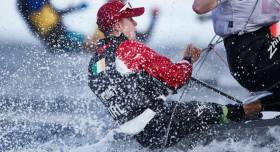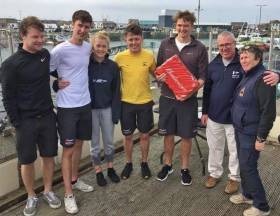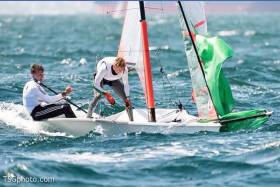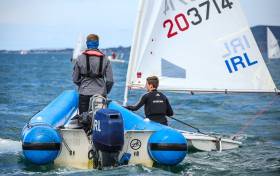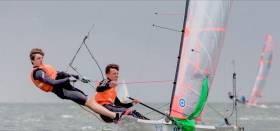Displaying items by tag: Harry Durcan
Durcan on Board Winning British Dragon in Vilamoura
Irish Dragon sailors were in action in Portugal at the weekend with Royal Cork and Baltimore's Harry Durcan on board the winning boat in round two of the Algarve Dragon Winter Cup at Vilamoura.
Durcan was part of a four-up British entry skippered by Pete Cooke with Torvar Mirsky and Peter Nicholas, who tied on points with Portugal's Pedro Rebelo de Andrade but won on the tie-break rule.
Also racing from Ireland was Dun Laoghaire's Jonathan Bourke with Conn Harte-Bourke and Sam Gullivan, who finished seventh in the 11-boat fleet.
Round three of the Cup sets sail on February 16th.
In a big year for Irish Dragon sailing, Kinsale Yacht Club will stage the class's prestigious Gold Cup this September.
Royal Cork's Durcan and Roberts Sailing on J122 El Ocaso are Overall Winners at Antigua Sailing Week
Royal Cork’s Harry Durcan and Grattan Roberts were part of the J122 El Ocaso that were declared overall winners of Antigua Sailing Week.
Racing onboard Chris Body’s J122 El Ocaso, they led CSA 2 by a slim margin of a single point going into the last day.
The crew were awarded the Lord Nelson Trophy as the overall Antigua Week 2023 winner.
 Chris Body’s J122 El Ocaso crew that includes Grattan Roberts and Harry Durcan from Royal Cork Photo: Paul Wyeth
Chris Body’s J122 El Ocaso crew that includes Grattan Roberts and Harry Durcan from Royal Cork Photo: Paul Wyeth
Louay Habib caught up with them after racing on the final day, first Durcan, then Roberts in the audio below.
 El Ocaso, GBR 4860, winners of the Lord Nelson Trophy 2023, at Antigua Sailing Week Photo: Paul Wyeth
El Ocaso, GBR 4860, winners of the Lord Nelson Trophy 2023, at Antigua Sailing Week Photo: Paul WyethHarry Durcan of Cork is “Sailor of the Month” for March
A rose is still a rose by any other name, but though Cork Institute of Technology is now Munster Technological University, its team keelboat sailing skipper is still Harry Durcan of Crosshaven.
And at the weekend he showed he’d lost none of the zip which had CIT as the Keelboat Champs racing J/80s at Howth back in March 2019, as they’ve done exactly the same thing again under the MTU moniker with the resumption of close-up sailing in March 2022. The margin after 18 races was 12 points over UCD, and while his crew of Ronan Cournane, Mark Murphy, Morgan McKnight and Charlie Moloney had something to do with it, one name has to go on the title, and that’s Harry Durcan.
Royal Cork's Durcan Helms 'Wildcard' J/70 to Success in Monaco
Wildcard J70 racing team from Cork led by William Twomey (bow), along with Harry Durcan (helm), Richie Harrington (tactics) and Gratton Roberts (trimming) got their J70 World Championship 2022 campaign underway with a successful Act1 of the Monaco sports-boat winter series over the past few days.
After a successful European championship last September in Denmark when the team was helmed by 17-year-old Harry Twomey and contained Rio Olympian Finn Lynch on tactics along with William Twomey, Sally O' Flynn and Harry Durcan.
"The Irish J/70 World Championship 2022 campaign is underway"
Wind conditions varied over the three days with a mixture of heavy and light winds. The sole Irish team finished off with a commanding bullet in the final race to wrap up the 1st Corinthian team overall in the 40 boat fleet that contained Olympic gold medalists and Americas Cup sailors.
 (Above and below) The RCYC J/70 Wildcard in action
(Above and below) The RCYC J/70 Wildcard in action

The series continues next month and continues onwards in February, and cumulates with the Monaco Primo cup in March.
The Cork-based team say they are looking forward to joining the Italian circuit for spring/summer for the final run into the Europeans in France this coming September and the World championship in Monaco in 10 months time.
 The J/70 fleet in Monaco
The J/70 fleet in Monaco
Irish Crew on Board Cowes Week IRC One Winner, J/111 McFly
Winners of Cowes Week IRC One division on the Solent this week was Tony Mack's UK-based J/111 McFly that included a notable Irish presence in her crew lineup.
Royal Cork's Harry Durcan was the mainsheet trimmer, Cathal Leigh-Doyle was the upwind trimmer with Kinsale Laser dinghy ace Darragh O'Sullivan also on board the 36-footer in the 16-boat fleet.
Results are here
Success in Cowes Week is only one part of Durcan's UK summer odyssey, the former 29er skiff helmsman sails with club mates on the Murphy family's Grand Soleil Nieulargo tomorrow in the Fastnet Race.
Durcan & Twomey Finish Ninth Overall In 29er Worlds
Harry Durcan and Harry Twomey finished ninth overall at the Zhik 29er World Championships in Poland, which drew to a close yesterday (Saturday 3 August), scoring Ireland’s best result ever in the competition.
And it marks another remarkable result for the Royal Cork duo who also placed second at the RYA Youth Nationals in Weymouth this past April.
That was despite the fact it was the first time former Optimist ace Twomey was helming a 29er in competition alongside March’s Sailor of the Month.
Theirs was the top Irish result from three pairs among 175 teams competing in Gdynia — the same venue where Team Ireland were racing in the Youth Worlds last month — with Durcan’s twin Johnny not far behind in 16th overall in his mixed pair with Lola Kohl.
Also competing for Ireland over the week were Charlie Cullen (Royal St George/National YC) and Ben Hogan, who placed sixth on the Bronze fleet.
Read how a unique tie-up with the US Virgin Islands led to eight Irish sailors contesting the Gdynia Championships by Chris Bateman here.
Harry Durcan is March “Sailor of the Month”
It was Cork crews all the way in yesterday’s intensely-fought final in the two-day Student Nationals in the J/80s at Howth Yacht Club.
But in the end, victory was taken by Cork Institute of Technology helmed in style by Harry Durcan. The final margin over University College Cork may only have been one point, yet CIT is now not only Irish champions, but they will be the national team in the Student Yachting Worlds in France in the Autumn.
More on this story here.
Tom Higgins & Harry Durcan Team Up for New 29er Campaign
This month's Californian 29–er skiff Worlds was youth sailors Harry Durcan and Harry Whitaker's last regatta together as the pair embark on different sailing and study plans.
Durcan will swap to crewing the 29er dinghy. His new helmsman is 2016 Irish and British Optimist national champion Tom Higgins of Dun Laoghaire's Royal St. George Yacht Club.
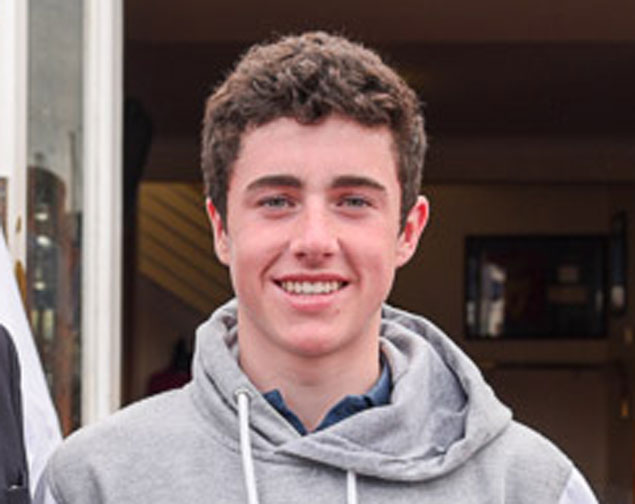 Dun Laoghaire's Tom Higgins who has moved from Optimist to Laser 4.7 and now to 29er skiff. Photo: Bob Bateman
Dun Laoghaire's Tom Higgins who has moved from Optimist to Laser 4.7 and now to 29er skiff. Photo: Bob Bateman
The pair have already started training and although the early goal back in April was to contest the Europeans this month in France they have not entered that regatta that began at the weekend. The campaign will last until next June 2018 and the end of sixth year studies. 'Once that is over I'll be heading into the Olympic 49er class, the young Cork Harbour sailor told Afloat.ie
Harry Whitaker, it is understood, will take a step back from competitive sailing but will continue to participate in team racing and yacht racing while going through college.
Show of Youth Sailing Strength for Royal St. George As Big Breeze Forecast for Junior All–Irelands
Tomorrow's All Ireland Junior sailing championships looks like it will get off to a wet and windy start for the 16–nominated junior sailing stars drawn from seven yacht clubs from around the country.
The Under–18 championships is scheduled to race over two days in West Cork's own TR3.6 two handed dinghies but the weather forecast for the Schull venue shows winds topping 40–knots for Saturday and the same again on Sunday.
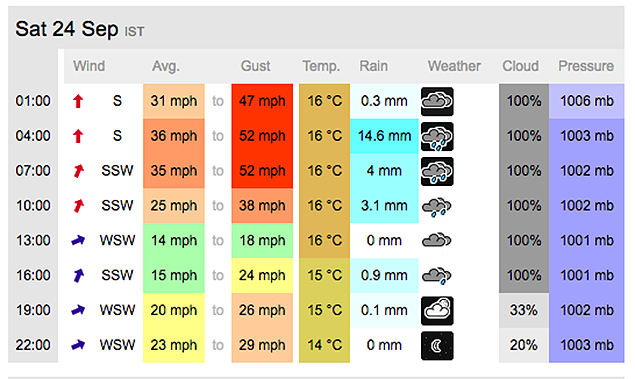 XC weather forecaster shows big winds in Schull, West Cork tomorrow
XC weather forecaster shows big winds in Schull, West Cork tomorrow
In a show of strength for Dublin's Royal St. George Yacht Club more than a third of the participants are drawn from the Dun Laoghaire club. RStGYC juniors are representing the RS200 (Toby Hudson Fowler), the RS Feva (Henry Start), Laser 4.7 (Peter Fagan), Optimist (Tom Higgins), Topper (Jack Fahy) and Kate Lyttle from the 420 class.
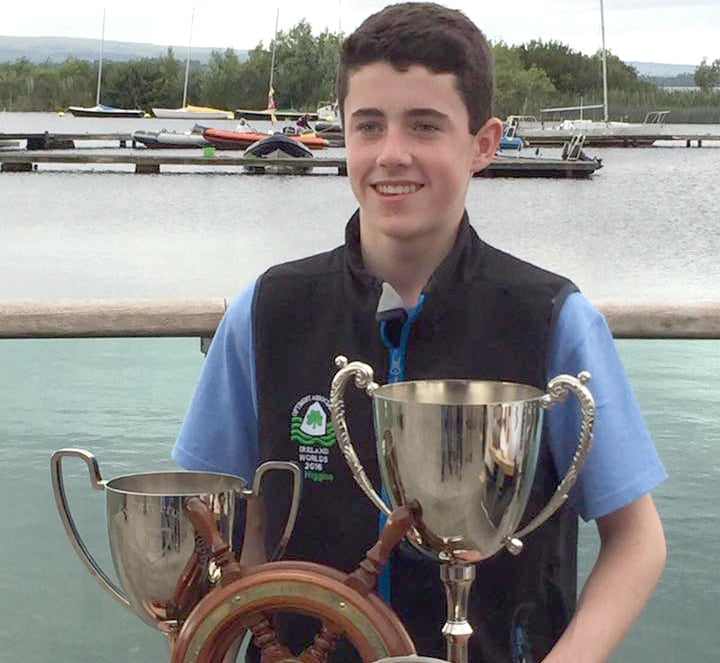 Multi–champion in the Optimist class, Tom Higgins from the Royal St. George, is nominated for this weekend's All Ireland Juniors in Schull
Multi–champion in the Optimist class, Tom Higgins from the Royal St. George, is nominated for this weekend's All Ireland Juniors in Schull
Royal Cork Yacht Club is the next biggest club on the water in Schull with four sailors involved. 29er skipper Harry Durcan and twin Johnny representing 29er and Laser Radials respectively. Harry Twomey represents the Optimist class and Sophie Crosby sails for the Toppers.
The National Yacht Club's Clare Gorman represents the Laser 4.7 and will defend the girls title and the NYC's Leah Rickard sails for the Optimists.
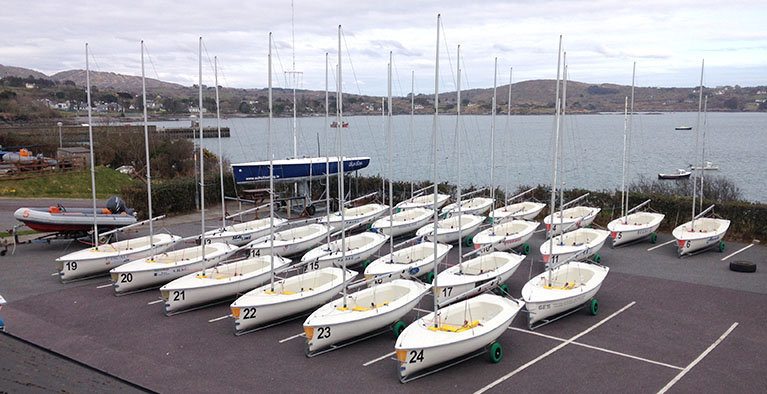 Schull's own TR3.6 dinghies ready for the junior all Ireland sailors. Photo: Fastnet Marine
Schull's own TR3.6 dinghies ready for the junior all Ireland sailors. Photo: Fastnet Marine
The West coast is represented by three clubs.Topaz sailors Adam Byrne and Dylan Reidy representing Dingle SC and Foynes YC respectively and Sligo Yacht Club sends Mirror ace Sarah White.
The 420 class is represented by Geoff Power of Waterford Harbour Sailing Club.
Full nominee list below
| Class | Name | Surname | Club |
|---|---|---|---|
| RS200 Junior | Toby | Hudson Fowler | Royal StGeorge YC |
| RS Feva | Henry | Start | Royal St George YC |
| Mirror | Sarah | White | Sligo YC |
| Laser 4.7 | Clare | Gorman | NYC |
| Laser 4.7 | Peter | Fagan | Royal St George YC |
| Laser Radial | Johnny | Durcan | RCYC/NYC |
| Topaz | Adam | Byrne | Dingle SC |
| Topaz | Dylan | Reidy | Foynes YC |
| Topper | Jack | Fahy | RSTGYC |
| Topper | Sophie | Crosby | RCYC |
| 420 | Geoff | Power | WHSC |
| 420 | Kate | Lyttle | RStGYC |
| OPTIMIST | Tom | Higgins | RSGYC |
| OPTIMIST | Harry | Twomey | RCYC&CHSC |
| OPTIMIST | Leah | Rickard | NYC |
| 29er | Harry | Durcan | RCYC |
Royal Cork Youth Skiff Pair Win UK 29er Champs
Royal Cork's Harry Durcan and Harry Whittaker have won the UK 29er National Championship in Torbay. After six days racing and 19 races in all, it all came down to the final race which they secured with a bullet giving them a two point lead over the rest of the fleet. Full results here. Conditions today were shifty at best and the Race Officer did well to get four races in to finish the final series.


























